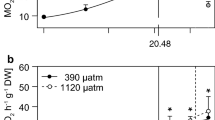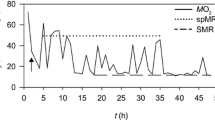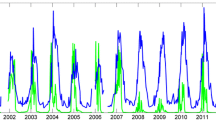Abstract
Marine organisms are exposed to increasingly acidic oceans, as a result of equilibration of surface ocean water with rising atmospheric CO2 concentrations. In this study, we examined the physiological response of Mytilus edulis from the Baltic Sea, grown for 2 months at 4 seawater pCO2 levels (39, 113, 243 and 405 Pa/385, 1,120, 2,400 and 4,000 μatm). Shell and somatic growth, calcification, oxygen consumption and \( {\text{NH}}_{4}^{ + } \) excretion rates were measured in order to test the hypothesis whether exposure to elevated seawater pCO2 is causally related to metabolic depression. During the experimental period, mussel shell mass and shell-free dry mass (SFDM) increased at least by a factor of two and three, respectively. However, shell length and shell mass growth decreased linearly with increasing pCO2 by 6–20 and 10–34%, while SFDM growth was not significantly affected by hypercapnia. We observed a parabolic change in routine metabolic rates with increasing pCO2 and the highest rates (+60%) at 243 Pa. \( {\text{NH}}_{4}^{ + } \) excretion rose linearly with increasing pCO2. Decreased O:N ratios at the highest seawater pCO2 indicate enhanced protein metabolism which may contribute to intracellular pH regulation. We suggest that reduced shell growth under severe acidification is not caused by (global) metabolic depression but is potentially due to synergistic effects of increased cellular energy demand and nitrogen loss.



Similar content being viewed by others
References
Addadi L, Joester D, Nudelman F, Weiner S (2006) Mollusk shell formation: a source of new concepts for understanding biomineralization processes. Chem Eur J 12:981–987
Bayne BL, Hawkins AJS (1997) Protein metabolism, the costs of growth, and genomic heterozygosity: experiments with the mussel Mytilus galloprovincialis Lmk. Physiol Zool 70:391–402
Berge JA, Bjerkeng B, Pettersen O, Schaanning MT, Oxnevad S (2006) Effects of increased sea water concentrations of CO2 on growth of the bivalve Mytilus edulis L. Chemosphere 62:681–687
Berggreen U, Hansen B, Kiorboe T (1988) Food size spectra, ingestion and growth of the copepod Acartia tonsa during development—implications for determination of copepod production. Mar Biol 99:341–352
Booth CE, McDonald DG, Walsh PJ (1984) Acid–base-balance in the sea mussel, Mytilus-edulis.1. Effects of hypoxia and air-exposure on hemolymph acid–base status. Mar Biol Lett 5:347–358
Boron WF (2004) Regulation of intracellular pH. Adv Physiol Educ 28:160–179
Cao L, Caldeira K (2008) Atmospheric CO2 stabilization and ocean acidification. Geophys Res Lett 35:L19609
Checkley DM, Dickson AG, Takahashi M, Radich JA, Eisenkolb N, Asch R (2009) Elevated CO2 enhances otolith growth in young fish. Science 324:1683
Comeau S, Jeffree R, Teyssie JL, Gattuso JP (2010) Response of the arctic pteropod Limacina helicina to projected future environmental conditions. PLoS ONE 5:e11362
Deigweiher K, Hirse T, Bock C, Lucassen M, Pörtner HO (2009) Hypercapnia induced shifts in gill energy budgets of Antarctic notothenioids. J Comp Physiol B 180:347–359
Dickson AG (1990) Standard potential of the reaction—AgClS + 1/2 H2 = AgS + HClAq and the standard acidity constant of the ion HSO4- in synthetic sea-water from 273.15-K to 318.15-K. J Chem Thermodyn 22:113–127
Dickson AG, Millero FJ (1987) A comparison of the equilibrium-constants for the dissociation of carbonic-acid in seawater media. Deep Sea Res A 34:1733–1743
Dickson AG, Afghan JD, Anderson GC (2003) Reference materials for oceanic CO2 analysis: a method for the certification of total alkalinity. Mar Chem 80:185–197
Dickson AG, Sabine CL, Christian JR (2007) Guide to best practices for ocean CO2 measurements. PICES Special Publications
Elliott JM, Davison W (1975) Energy equivalents of oxygen-consumption in animal energetics. Oecologia 19:195–201
Enderlein P, Wahl M (2004) Dominance of blue mussels versus consumer-mediated enhancement of benthic diversity. J Sea Res 51:145–155
Fabry VJ, Seibel BA, Feely RA, Orr JC (2008) Impacts of ocean acidification on marine fauna and ecosystem processes. ICES J Mar Sci 65:414–432
Famme P (1980) Effect of shell valve closure by the mussel Mytilus edulis L. on the rate of oxygen consumption in declining oxygen-tension. Comp Biochem Physiol A Physiol 67:167–170
Feely RA, Sabine CL, Hernandez-Ayon JM, Ianson D, Hales B (2008) Evidence for upwelling of corrosive “acidified” water onto the continental shelf. Science 320:1490–1492
Gazeau F, Quiblier C, Jansen JM, Gattuso JP, Middelburg JJ, Heip CHR (2007) Impact of elevated CO2 on shellfish calcification. Geophys Res Lett 34:L07603. doi10.1029/2006GL028554
Gazeau F, Gattuso JP, Dawber C, Pronker AE, Peene F, Peene J, Heip CHR, Middelburg JJ (2010) Effect of ocean acidification on the early life stages of the blue mussel Mytilus edulis. Biogeoscience 7:2051–2060
Guppy M, Withers P (1999) Metabolic depression in animals: physiological perspectives and biochemical generalizations. Biol Rev 74:1–40
Gutowska MA, Pörtner HO, Melzner F (2008) Growth and calcification in the cephalopod Sepia officinalis under elevated seawater pCO2. Mar Ecol Prog Ser 373:303–309
Gutowska MA, Melzner F, Langenbuch M, Bock C, Claireaux G, Portner HO (2009) Acid–base regulatory ability of the cephalopod (Sepia officinalis) in response to environmental hypercapnia. J Comp Physiol B 180:323–335
Hatcher A, Grant J, Schofield B (1997) Seasonal changes in the metabolism of cultured mussels (Mytilus edulis L.) from a Nova Scotian inlet: the effects of winter ice cover and nutritive stress. J Exp Mar Biol Ecol 217:63–78
Hawkins AJS (1985) Relationships between the synthesis and breakdown of protein, dietary absorption and turnovers of nitrogen and carbon in the blue mussel, Mytilus edulis-L. Oecologia 66:42–49
Hawkins AJS, Widdows J, Bayne BL (1989) The relevance of whole-body protein-metabolism to measured costs of maintenance and growth in Mytilus edulis. Physiol Zool 62:745–763
Holmes RM, Aminot A, Kerouel R, Hooker BA, Peterson BJ (1999) A simple and precise method for measuring ammonium in marine and freshwater ecosystems. Can J Fish Aquat Sci 56:1801–1808
Ismar SMH, Hansen T, Sommer U (2008) Effect of food concentration and type of diet on Acartia survival and naupliar development. Mar Biol 154:335–343
Kaloyianni M, Stamatiou R, Dailianis S (2005) Zinc and 17 beta-estradiol induce modifications in Na+/H+ exchanger and pyruvate kinase activity, through protein kinase C in isolated mantle/gonad cells of Mytilus galloprovincialis. Comp Biochem Physiol C Toxicol Pharmacol 141:257–266
Knepper MA (2008) Physiology courier service for ammonia. Nature 456:336–337
Körner S, Das SK, Veenstra S, Vermaat JE (2001) The effect of pH variation at the ammonium/ammonia equilibrium in wastewater and its toxicity to Lemna gibba. Aquat Bot 71:71–78
Kreeger DA, Langdon CJ (1993) Effect of dietary-protein content on growth of juvenile mussels, Mytilus trossulus (Gould 1850). Biol Bull 185:123–139
Kreeger DA, Hawkins AJS, Bayne BL (1996) Use of dual-labeled microcapsules to discern the physiological fates of assimilated carbohydrate, protein carbon, and protein nitrogen in suspension-feeding organisms. Limnol Oceanogr 41:208–215
Langenbuch M, Pörtner HO (2002) Changes in metabolic rate and N excretion in the marine invertebrate Sipunculus nudus under conditions of environmental hypercapnia: identifying effective acid–base variables. J Exp Biol 205:1153–1160
Langenbuch M, Pörtner HO (2003) Energy budget of hepatocytes from Antarctic fish (Pachycara brachycephalum and Lepidonotothen kempi) as a function of ambient CO2: pH-dependent limitations of cellular protein biosynthesis? J Exp Biol 206:3895–3903
Langenbuch M, Bock C, Leibfritz D, Pörtner HO (2006) Effects of environmental hypercapnia on animal physiology: A 13C NMR study of protein synthesis rates in the marine invertebrate Sipunculus nudus. Comp Biochem Physiol A Mol Integr Physiol 144:479–484
Lauff RF, Wood CH (1996) Respiratory gas exchange, nitrogenous waste excretion, and fuel usage during aerobic swimming in juvenile rainbow trout. J Comp Physiol B 166:501–509
Lewis E, Wallace DWR (1998) Program developed for CO2 system calculations. Oak Ridge, Oak Ridge National Laboratory ORNL/CDIAC-105
Lindinger MI, Lauren DJ, McDonald DG (1984) Acid–base-balance in the sea mussel, Mytilus edulis. 3. Effects of environmental hypercapnia on intracellular and extracellular acid–base-balance. Mar Biol Lett 5:371–381
Matsushiro A, Miyashita T (2004) Evolution of hard-tissue mineralization: comparison of the inner skeletal system and the outer shell system. J Bone Miner Metab 22:163–169
Mayzaud P, Conover RJ (1988) O:N atomic ratio as a tool to describe zooplankton metabolism. Mar Ecol Prog Ser 45:289–302
Mehrbach C, Culberso CH, Hawley JE, Pytkowic RM (1973) Measurement of apparent dissociation-constants of carbonic-acid in seawater at atmospheric-pressure. Limnol Oceanogr 18:897–907
Melzner F, Göbel S, Langenbuch M, Gutowska MA, Pörtner HO, Lucassen M (2009) Swimming performance in Atlantic Cod (Gadus morhua) following long-term (4–12 months) acclimation to elevated seawater pCO2. Aquat Toxicol 92:30–37
Michaelidis B, Ouzounis C, Paleras A, Pörtner HO (2005) Effects of long-term moderate hypercapnia on acid–base balance and growth rate in marine mussels Mytilus galloprovincialis. Mar Ecol Prog Ser 293:109–118
Munday PL, Crawley NE, Nilsson GE (2009) Interacting effects of elevated temperature and ocean acidification on the aerobic performance of coral reef fishes. Mar Ecol Prog Ser 388:235–242
Nawata CM, Hung CCY, Tsui TKN, Wilson JM, Wright PA, Wood CM (2007) Ammonia excretion in rainbow trout (Oncorhynchus mykiss): evidence for Rh glycoprotein and H+-ATPase involvement. Physiol Genomics 31:463–474
Okumus I, Stirling HP (1994) Physiological energetics of cultivated mussel (Mytilus edulis) populations in 2 Scottish west-coast sea lochs. Mar Biol 119:125–131
Pagliarani A, Bandiera P, Ventrella V, Trombetti F, Manuzzi MP, Pirini M, Borgatti AR (2008) Response of Na+-dependent ATPase activities to the contaminant ammonia nitrogen in Tapes philippinarum: possible ATPase involvement in ammonium transport. Arch Environ Contam Toxicol 55:49–56
Petes LE, Menge BA, Murphy GD (2007) Environmental stress decreases survival, growth, and reproduction in New Zealand mussels. J Exp Mar Biol Ecol 351:83–91
Pörtner HO, Reipschlager A, Heisler N (1998) Acid–base regulation, metabolism and energetics in Sipunculus nudus as a function of ambient carbon dioxide level. J Exp Biol 201:43–55
Pörtner HO, Langenbuch M, Reipschläger A (2004) Biological impact of elevated ocean CO2 concentrations: Lessons from animal physiology and earth history. J Oceanogr 60:705–718
Ries JB, Cohen AL, McCorkle DC (2009) Marine calcifiers exhibit mixed responses to CO2-induced ocean acidification. Geology 37:1131–1134
Rosa R, Seibel BA (2008) Synergistic effects of climate-related variables suggest future physiological impairment in a top oceanic predator. Proc Natl Acad Sci U S A 105:20776–20780
Tedengren M, Kautsky N (1986) Comparative-study of the physiology and its probable effect on size in blue mussels (Mytilus edulis L) from the North-Sea and the northern Baltic proper. Ophelia 25:147–155
Tedengren M, Kautsky N (1987) Comparative stress response to diesel oil and salinity changes of the blue mussel, Mytilus edulis from the Baltic and North Seas. Ophelia 28:1–9
Tedengren M, Andre C, Johannesson K, Kautsky N (1990) Genotypic and phenotypic differences between Baltic and North-Sea populations of Mytilus edulis evaluated through reciprocal transplantations.3. Physiology. Mar Ecol Prog Ser 59:221–227
Thomsen J, Gutowska MA, Saphörster J, Heinemann A, Trübenbach K, Fietzke J, Hiebenthal C, Eisenhauer A, Körtzinger A, Wahl M, Melzner F (2010) Calcifying invertebrates succeed in a naturally CO2 enriched coastal habitat but are threatened by high levels of future acidification. Biogeosci Discuss 7:5119–5156
Wang WX, Widdows J (1993) Metabolic responses of the common mussel Mytilus edulis to hypoxia and anoxia. Mar Ecol Prog Ser 95:205–214
Whitman Miller A, Reynolds AC, Sobrino C, Riedel GF (2009) Shellfish face uncertain future in high CO2 world: influence of acidification on oyster larvae calcification and growth in estuaries. PLoS ONE 4:e5661
Wilkie MP (1997) Mechanisms of ammonia excretion across fish gills. Comp Biochem Physiol A Comp Physiol 118:39–50
Wilkie MP (2002) Ammonia excretion and urea handling by fish gills: present understanding and future research challenges. J Exp Zool 293:284–301
Wood HL, Spicer JI, Widdicombe S (2008) Ocean acidification may increase calcification rates, but at a cost. Proc R Soc B Biol Sci 275:1767–1773
Wright PA, Randall DJ, Perry SF (1989) Fish gill water boundary-layer—a site of linkage between carbon-dioxide and ammonia excretion. J Comp Physiol B 158:627–635
Acknowledgments
We thank Ullrike Panknin for her technical support with algae culturing and monitoring of experimental water parameters, Peter Fritsche for the help with the ammonium measurements and Sebastian Fessler for supporting the carbonate system measurements. We like to thank Magdalena A. Gutowska for her advice to improve the manuscript. This study was funded by the DFG Excellence cluster ‘Future Ocean’ and the German ‘Biological impacts of ocean acidification (BIOACID)’ project 3.1.3, funded by the Federal Ministry of Education and Research (BMBF, FKZ 03F0608A).
Author information
Authors and Affiliations
Corresponding author
Additional information
Communicated by H. O. Pörtner.
Rights and permissions
About this article
Cite this article
Thomsen, J., Melzner, F. Moderate seawater acidification does not elicit long-term metabolic depression in the blue mussel Mytilus edulis . Mar Biol 157, 2667–2676 (2010). https://doi.org/10.1007/s00227-010-1527-0
Received:
Accepted:
Published:
Issue Date:
DOI: https://doi.org/10.1007/s00227-010-1527-0




